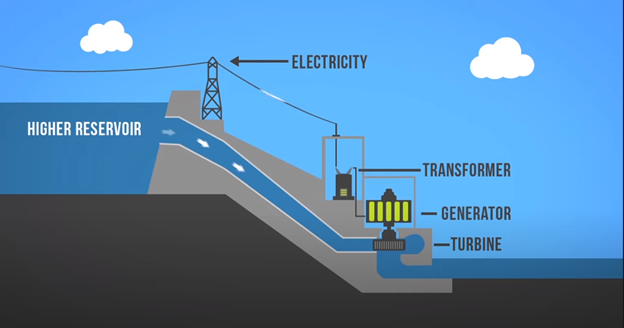Tech Breakdown: How the Hoover Dam Works
By Nassim Terzout
Unquestionably, one of the greatest projects of all time in both energy and engineering is the Hoover Dam. Constructed during the Great Depression between 1931 and 1936, the Hoover Dam was a project that required efforts from thousands of workers, many of them losing their lives in the process [1]. So why risk so much? Why test the limits of engineering and risk millions of dollars and thousands of lives to produce this dam? In this article we will look at why the United States government chose to build this dam, how it works, and how it has helped shape the southwestern United States for generations to come.
In the late 1890’s and early 1900’s, electric power generation and transmission technology grew immensely. As a result, the Colorado River’s massive body of water was viewed as a potential source for mass hydroelectric power generation. In addition to this, the government wanted to regulate the flow of water in the river and potentially use the water as a resource for crops in the southwestern states. In order to utilize the river to its full potential, multiple ideas were considered, and many were rejected [1]. In 1922, a report by the Bureau of Reclamation suggested the use of an arch-gravity dam made of concrete. The report chose the Black Canyon as the best location, however many were skeptical as a dam located in such a narrow point would be immensely difficult to build [1].
Diagram of an Arch-Gravity Dam; Top and Side View. Original image can be found here.
As seen in both views, an arch dam is fairly basic in nature. The entire concept is to curve the dam horizontally and vertically. By doing both, engineers can reallocate pressure that builds-up in the extremities of the dam [3]. The Hoover Dam follows this same format as an arch dam, however it is vertically curved to push the water downwards and is thus called an arch-gravity dam. The flowing motion of water is exactly how the Hoover Dam produces power. Similar to most dams, the Hoover Dam runs water through 17 turbines: 8 on the Nevada wing and 9 on the Arizona wing [5]. Turbines will take the force from the water and begin to spin. This motion connected to a generator will use an electromagnetic field to generate electricity in a process known as electromagnetic induction [2]. The electricity is then passed along through power lines as current that can be used for housing or industry. In this process we have essentially converted mechanical energy from flowing water into electrical energy [4].
Diagram of Energy Generation at a dam. Original image can be found here.
As impressive as hydroelectricity is, the Hoover Dam is famous as it takes the process to another level. The Hoover Dam continuously produces 2074 megawatts of power that supplies 1.3 million users in the United States [4]. If that is not impressive enough, the Hoover Dam was one of the first projects to implement utility poles on roughly 45-degree angles! Such remarkable characteristics and engineering succeeding in the 1930s is what makes the Hoover Dam so special. Today it still stands strong and although it requires occasional maintenance, it is still an extremely valuable asset to renewable energy in the United States and is an awesome spot for sightseeing!
Interested in learning more about hydroelectricity? Check out our past article here!
References
[1] Stevens, Joseph E. (1988). Hoover Dam: An American Adventure. Norman, OK: University of Oklahoma Press pp. 324. 1988 [Accessed: 28-Feb-2021]. Available: https://archive.org/details/hooverdamamerica00stev
[2] How Does A Generator Create Electricity? Article on How Generators Work. [Online]. Available: https://www.generatorsource.com/How_Generators_Work.aspx#:~:text=An%20electric%20generator%20is%20a,electrical%20energy%20as%20the%20output.&text=Instead%2C%20it%20uses%20the%20mechanical,through%20an%20external%20electric%20circuit. [Accessed: 28-Feb-2021].
[3] T. D. Group, “Types of Dams: USSD: United States Society on Dams,” USSD. [Online]. Available: https://www.ussdams.org/dam-levee-education/overview/types-of-dams/. [Accessed: 28-Feb-2021].
[4] Student Energy, “Hydropower 101” [Online]. Available: https://www.youtube.com/watch?v=q8HmRLCgDAI [Accessed: 28-Feb-2021].
[5] L. C. R. W. T. Bureau of Reclamation, “HOOVER DAM,” Hoover Dam | Bureau of Reclamation. [Online]. Available: https://www.usbr.gov/lc/hooverdam/faqs/powerfaq.html#:~:text=There%2017%20main%20turbines%20in,capacity%20of%20about%202%2C080%20megawatts. [Accessed: 27-Feb-2021].


